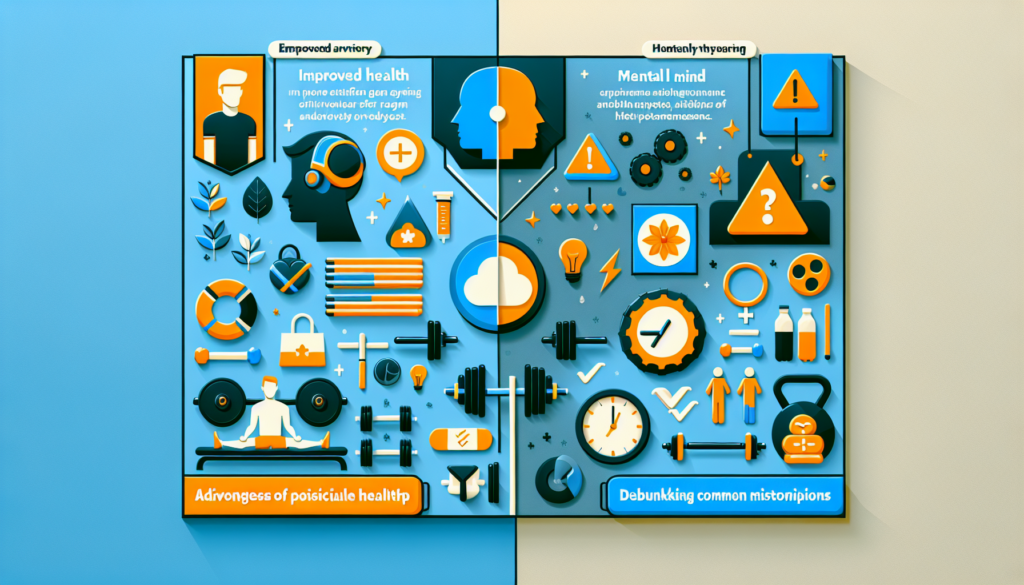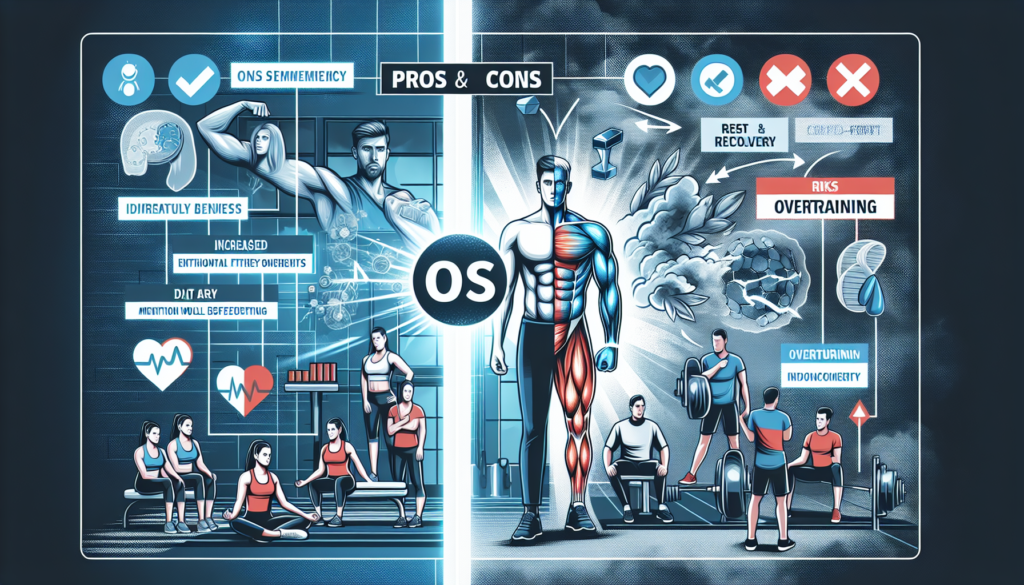Should You Go to the Gym Every Day?
Going to the gym is a popular way to take care of your physical health, but have you ever wondered if it’s necessary to go there every single day? In this article, we will explore the benefits and potential drawbacks of going to the gym on a daily basis. By examining the impact it can have on your body, mind, and overall well-being, we’ll help you make an informed decision about how often you should hit the gym. So grab your workout clothes and let’s find out if daily gym sessions are right for you!
Benefits of Going to the Gym Every Day
Improved physical fitness
Going to the gym every day can greatly improve your physical fitness. Regular exercise helps to increase your cardiovascular endurance, build strong muscles, and improve your overall strength. Whether you choose to engage in cardio exercises like running or cycling, or focus on strength training exercises with weights, consistently going to the gym can help you achieve your fitness goals and improve your physical health.
Weight management and control
One of the key benefits of going to the gym every day is its impact on weight management and control. Engaging in regular exercise helps to burn calories and increase your metabolism, which can aid in weight loss or weight maintenance. By incorporating both cardio exercises and strength training into your gym routine, you can effectively manage your weight and achieve a healthier body composition.
Increased muscle strength and endurance
If increasing your muscle strength and endurance is one of your fitness goals, going to the gym every day is a great way to achieve it. Strength training exercises, such as lifting weights or using resistance machines, help to build and tone your muscles. With consistent gym sessions, you’ll see improvements in your muscle strength and endurance over time, allowing you to perform daily activities with greater ease and efficiency.
Boost in mood and mental well-being
Exercise has been shown to release endorphins, the feel-good hormones in your brain. By going to the gym every day and engaging in physical activity, you can experience a noticeable boost in your mood and overall mental well-being. Regular gym sessions can reduce stress, anxiety, and symptoms of depression, and promote better mental health. It’s a natural and effective way to improve your emotional well-being and increase your overall happiness.
Reduced risk of chronic diseases
Regular exercise, including going to the gym every day, has been linked to a reduced risk of chronic diseases. Physical activity helps to lower the risk of conditions such as heart disease, high blood pressure, type 2 diabetes, and certain types of cancer. By incorporating daily gym sessions into your routine, you can significantly reduce your chances of developing these chronic diseases and enjoy better long-term health.
Improved sleep quality
If you struggle with getting a good night’s sleep, going to the gym every day can help improve your sleep quality. Exercise has been shown to regulate sleep patterns and promote deeper, more restful sleep. Gym sessions can help tire your body and decrease feelings of restlessness, making it easier for you to fall asleep and stay asleep throughout the night. Just be sure to finish your workout several hours before bedtime to allow your body to wind down.
Enhanced cognitive function
Exercise not only benefits your physical fitness but also contributes to better cognitive function. Going to the gym every day can improve your memory, attention span, and ability to focus. Exercise helps increase blood flow to the brain, which enhances brain function and stimulates the growth of new neurons. With regular gym sessions, you can experience improved cognitive abilities and better overall mental clarity.
Potential Drawbacks of Going to the Gym Every Day
Increased risk of overtraining
While going to the gym every day has numerous benefits, it’s important to be mindful of the potential drawbacks. One of these drawbacks is an increased risk of overtraining. Overtraining occurs when you push your body beyond its ability to recover, leading to fatigue, decreased performance, and increased susceptibility to injuries. It’s essential to listen to your body and give it sufficient rest to avoid overtraining and optimize your results.
Higher chance of injury
Another potential drawback of frequent gym sessions is a higher chance of injury. When you’re constantly pushing yourself in the gym, using heavy weights or training with high intensity, there’s a greater risk of accidents or strain on your muscles and joints. It’s crucial to prioritize proper form and technique, gradually increase the intensity of your workouts, and allow for adequate rest and recovery to minimize the risk of injuries.
Lack of rest and recovery
Going to the gym every day may lead to a lack of rest and recovery, especially if you’re not allowing enough time for your body to recuperate between workouts. Rest days are essential to allow your muscles to repair and grow stronger. Without adequate rest, your performance may suffer, and you may be more prone to fatigue and injuries. It’s important to strike a balance between exercise and rest to optimize your fitness gains.
Burnout and decreased motivation
Consistently going to the gym every day can sometimes lead to burnout and decreased motivation. If you push yourself too hard without allowing for enough variety or rest, you may start feeling mentally and physically exhausted. It’s important to listen to your body and give it the occasional break to prevent burnout. Incorporating different types of exercises, trying new workouts, and setting realistic goals can help maintain your motivation and keep workouts enjoyable.
Time commitment and scheduling challenges
One factor to consider before committing to going to the gym every day is the time commitment and potential scheduling challenges. Depending on your personal and professional commitments, finding time for daily gym sessions can be difficult. It’s important to assess your schedule and determine if going to the gym every day is realistic for you. If time is limited, consider alternative forms of exercise or finding creative ways to incorporate physical activity into your daily routine.
Expense of gym memberships or equipment
Gym memberships or purchasing exercise equipment can be expensive, especially if you’re planning to go to the gym every day. It’s important to assess your budget and determine if investing in a gym membership or equipment aligns with your financial situation. Fortunately, there are alternative options like home workouts, outdoor activities, or group fitness classes that can be more cost-effective while still providing beneficial exercise opportunities.
Lack of variety and boredom
Going to the gym every day may eventually lead to a lack of variety and boredom in your workouts. Doing the same exercises day after day can become monotonous and decrease your motivation to continue. To combat this, it’s important to incorporate a variety of exercises, try different workout programs or classes, and set new fitness goals to keep your gym routine exciting and engaging. Finding enjoyment in exercise is key to maintaining a consistent gym routine.

Factors to Consider Before Going to the Gym Every Day
Individual fitness goals
Before committing to going to the gym every day, it’s important to consider your individual fitness goals. Clarify what you hope to achieve through regular exercise and how frequently the gym will help you reach those goals. Whether your focus is weight loss, building muscle, increasing endurance, or improving overall health, understanding your goals will help guide your decision on gym frequency.
Current fitness level
Another important factor to consider is your current fitness level. If you’re just starting your fitness journey or have been inactive for a while, going to the gym every day may be too much too soon. It’s crucial to gradually build up your fitness level and allow your body time to adapt to increased physical activity. Start with fewer gym sessions per week and gradually increase as your fitness improves and your body becomes more accustomed to exercise.
Health and medical conditions
Your health and any existing medical conditions should also be taken into consideration before committing to daily gym sessions. If you have any underlying health issues or medical conditions, it’s important to consult with a healthcare professional before starting a new exercise routine. They can evaluate the suitability of the gym every day for your specific situation and provide guidance on modifications or precautions you may need to take.
Personal time availability
One of the practical factors to consider is your personal time availability. Going to the gym every day requires a significant time commitment, including travel time, workout sessions, and post-workout recovery. Assess your daily schedule and determine if you have enough time to dedicate to the gym. It’s important to be realistic about the time you can realistically commit in order to maintain consistency and avoid burnout.
Exercise preferences
Lastly, consider your exercise preferences when deciding to go to the gym every day. Some individuals thrive in a gym environment and prefer working out with various equipment and machines. Others may find more enjoyment in outdoor activities, group classes, or at-home workouts. Understanding your exercise preferences and what type of physical activity brings you the most satisfaction can help in determining if going to the gym every day aligns with your personal preferences.
Balancing Frequency and Intensity
Understanding the concept of progressive overload
To find the right balance between gym frequency and intensity, it’s essential to understand the concept of progressive overload. Progressive overload refers to gradually increasing the intensity, duration, or frequency of your workouts to continually challenge your body and stimulate adaptation and growth. It’s important to strike a balance between pushing yourself enough to see progress without overdoing it and risking overtraining or injury.
Determining the appropriate frequency of workouts
The appropriate frequency of workouts varies depending on your individual goals and fitness level. While going to the gym every day may be suitable for some individuals, others may benefit from a more balanced approach with rest days incorporated. If your goal is general fitness and health, aiming for 3-5 gym sessions per week can be sufficient. However, if your goals are more specific, such as muscle building or athletic performance, you may need to increase the frequency of your gym sessions.
Importance of rest and recovery days
Rest and recovery days are just as crucial as your gym sessions. Rest days allow your muscles to repair and rebuild, reducing the likelihood of overuse injuries and fatigue. The frequency of rest days will depend on your fitness level, intensity of workouts, and your body’s ability to recover. Aim for at least 1-2 rest days per week and consider incorporating active recovery, such as light stretching or low-intensity activities, to aid in the recovery process.
Alternating between high and low-intensity workouts
To find a good balance in your gym routine, it’s beneficial to alternate between high and low-intensity workouts. High-intensity workouts, such as HIIT (High-Intensity Interval Training), can be challenging and effective for calorie burning and cardiovascular fitness. However, they should be balanced with low-intensity workouts, like stretching or yoga, to promote recovery and prevent excessive strain on your body.
Incorporating active rest days
Active rest days are a great way to maintain consistency while still allowing your body to recover. Instead of completely resting, engage in low-intensity activities such as walking, swimming, or light cycling. These activities promote blood flow, aid in muscle recovery, and can help reduce muscle soreness. Active rest days enable you to stay active while giving your body the rest it needs between more intense gym sessions.

Creating an Effective Gym Routine
Setting specific and realistic goals
When creating an effective gym routine, it’s important to set specific and realistic goals. Define what you want to achieve and establish measurable objectives that can guide your workouts. Whether your goals are centered around weight loss, strength gain, or overall fitness improvement, setting clear goals will help you stay focused and motivated throughout your gym journey.
Selecting suitable exercises and workouts
Choosing suitable exercises and workouts is crucial for an effective gym routine. Consider exercises that align with your goals and preferences. If you’re looking to build strength, incorporate compound exercises like squats, deadlifts, and bench presses. For cardiovascular fitness, include exercises like running, cycling, or rowing. Experiment with different exercises, equipment, and workout styles to find what works best for you and keeps your gym sessions engaging and enjoyable.
Incorporating various types of exercise
To prevent boredom and continually challenge your body, it’s important to incorporate various types of exercise into your gym routine. Mix and match cardiovascular exercises, strength training, flexibility work, and functional movements to target different muscle groups and improve overall fitness. Switching up your routine not only keeps your workouts interesting but also helps prevent plateaus and promotes well-rounded fitness.
Establishing a balanced routine
An effective gym routine should be well-balanced, targeting different muscle groups and incorporating both cardio and strength training. Aim to include exercises that work different areas of your body throughout the week. For example, you can dedicate specific days to upper body, lower body, and core workouts. This balanced approach ensures that you’re addressing all aspects of physical fitness and reducing the risk of muscle imbalances or overuse injuries.
Monitoring and tracking progress
To ensure your gym routine is effective, it’s important to monitor and track your progress. Keep a record of your workouts, noting the exercises, weights, sets, and reps you perform. Tracking your progress allows you to see improvements over time, adjust your routine accordingly, and stay motivated. Additionally, consider performing regular fitness assessments or measurements to objectively evaluate your progress and make necessary adjustments to your gym routine.
Tips for Consistency and Motivation
Finding enjoyment in exercise
One of the key factors in maintaining consistency with your gym routine is finding enjoyment in exercise. Experiment with different types of workouts, classes, or activities to discover what sparks joy for you. Whether it’s dancing, swimming, lifting weights, or playing a sport, choose activities that you genuinely enjoy and look forward to. When you find pleasure in exercise, it becomes easier to stay consistent and motivated.
Setting a schedule and sticking to it
Establishing a schedule and sticking to it helps build consistency and ensure that you stay on track with your gym routine. Determine the best time of day for your gym sessions and create a schedule that aligns with your daily commitments. Treat your gym time as a non-negotiable appointment and prioritize it like any other important task. By setting a regular schedule and committing to it, you’re more likely to stay consistent and make exercise a habit.
Seeking support from others
Seeking support from others can greatly enhance your consistency and motivation in going to the gym every day. Find a workout buddy or join a fitness community to provide accountability and encouragement. Working out with others can make gym sessions more enjoyable and create a sense of camaraderie. Additionally, consider hiring a personal trainer or seeking advice from fitness professionals to receive expert guidance and motivation on your gym journey.
Varying the gym routine
Adding variety to your gym routine is essential for long-term consistency. Continually doing the same exercises and workouts can lead to boredom and decreased motivation. Keep your routine fresh and exciting by incorporating new exercises, trying different equipment, or exploring alternative gym classes. Mixing up your routine not only challenges your body in different ways but also keeps you engaged and motivated to continue.
Rewarding yourself for achievements
Rewards can serve as positive reinforcement and help maintain motivation for going to the gym every day. Set small milestones or goals for yourself and reward yourself when you achieve them. These rewards can be non-food related, such as treating yourself to a massage, buying new workout clothes, or enjoying a day of relaxation. Celebrating your achievements and progress can boost your motivation and make your gym journey more enjoyable.
Alternatives to Going to the Gym Every Day
Outdoor activities and sports
If going to the gym every day doesn’t fit your lifestyle or preferences, there are plenty of alternatives that still provide ample physical activity. Engaging in outdoor activities and sports like hiking, cycling, swimming, or playing basketball can be excellent alternatives to the gym. These activities not only offer the benefits of exercise but also allow you to enjoy the outdoors and experience a change of scenery.
Home workouts and bodyweight exercises
For those who prefer the convenience of exercising at home, home workouts and bodyweight exercises can be effective alternatives to the gym. With minimal or no equipment required, bodyweight exercises like push-ups, squats, lunges, and planks can provide a challenging full-body workout. Additionally, there are numerous online resources and fitness apps that offer guided home workout programs to suit various fitness levels and goals.
Group fitness classes
Group fitness classes provide a social and motivating environment for exercise. Whether it’s a dance class, yoga session, or high-intensity interval training (HIIT) class, group fitness classes cater to a variety of interests and fitness levels. Joining group classes can provide structure, guidance, and an opportunity to connect with like-minded individuals. It’s a great way to stay active and motivated without the need for daily gym visits.
Active hobbies and recreational activities
Active hobbies and recreational activities can be excellent alternatives to the gym, especially for those who prefer a less structured approach to exercise. Engaging in activities like gardening, dancing, martial arts, or even household chores can provide physical activity and be enjoyable at the same time. The key is to find activities that you genuinely enjoy and that allow you to move your body.
Combining gym workouts with other forms of physical activity
Finding a balance between going to the gym and engaging in other forms of physical activity is a great way to maintain a varied and sustainable fitness routine. Incorporate gym workouts into your weekly routine while also participating in other activities like yoga, swimming, or team sports. This combination allows you to experience the benefits of the gym while enjoying a range of activities that provide different types of exercise.
Listening to Your Body’s Needs
Recognizing signs of overtraining and burnout
Listening to your body’s needs is crucial to avoiding overtraining and burnout. Pay attention to warning signs such as persistent fatigue, decreased performance, irritability, disrupted sleep patterns, or frequent injuries. These can indicate that you’re pushing yourself too hard and need to dial back the intensity or include more rest days. By recognizing and responding to these signs, you can optimize your progress and prevent long-term physical and mental exhaustion.
Adjusting workout frequency and intensity accordingly
It’s important to adjust your workout frequency and intensity according to your body’s needs. If you’re feeling particularly fatigued or recovering from an injury, it may be necessary to decrease the frequency of your gym sessions or modify the intensity of your workouts. Conversely, if you’re feeling energized and progressing well, you may consider increasing the frequency or intensity of your workouts. Listen to your body’s signals and make adjustments accordingly to ensure sustainable progress and prevent setbacks.
Prioritizing rest and recovery when necessary
Rest and recovery should always be a priority when it comes to exercise. Your body needs time to repair and rebuild after intense gym sessions. Make sure to incorporate rest days into your routine and prioritize quality sleep. If you’re feeling particularly sore or fatigued, consider active recovery days with gentle activities like stretching or light cardio. Prioritizing rest allows your body to fully recharge and supports better performance and overall well-being.
Seeking professional guidance when in doubt
If you’re unsure about how to listen to your body’s needs or balance your gym routine, don’t hesitate to seek professional guidance. A qualified personal trainer or fitness coach can provide valuable insight, tailor workouts to your needs, and help you navigate any challenges or uncertainties. They can offer advice on technique, program design, and rest and recovery strategies. Investing in professional guidance can optimize your gym experience and help you achieve your desired fitness outcomes.
Conclusion
In conclusion, whether or not you should go to the gym every day depends on your individual circumstances, preferences, and fitness goals. Going to the gym every day can provide numerous benefits, including improved physical fitness, weight management, increased muscle strength, enhanced mood, reduced risk of chronic diseases, improved sleep quality, and enhanced cognitive function. However, it’s important to consider potential drawbacks such as overtraining, increased risk of injury, lack of rest and recovery, burnout, time commitment, expense, and lack of variety.
Before committing to daily gym sessions, factors such as individual fitness goals, current fitness level, health conditions, personal time availability, and exercise preferences should be taken into account. Balancing frequency and intensity through progressive overload, rest and recovery, and incorporating active rest days is key to optimizing your gym routine. Creating an effective gym routine involves setting goals, selecting suitable exercises, incorporating variety, and tracking progress. Consistency and motivation can be enhanced by finding enjoyment in exercise, setting a schedule, seeking support, varying the gym routine, and rewarding yourself for achievements.
If going to the gym every day isn’t feasible or desirable, alternatives like outdoor activities, home workouts, group fitness classes, active hobbies, and incorporating other forms of physical activity can provide effective ways to stay active and fit. Furthermore, listening to your body’s needs, recognizing signs of overtraining and burnout, adjusting workout frequency and intensity accordingly, prioritizing rest and recovery, and seeking professional guidance when needed are essential for a sustainable and enjoyable fitness journey. Ultimately, with careful consideration of your personal goals and circumstances, finding a balanced approach to exercise and making fitness a sustainable and enjoyable part of your lifestyle is key.
















It's great that you talked about how business insurance can provide financial protection against unexpected events and help ensure the…
I like that you mentioned how business insurance is essential for protecting your bottom line and the long-term viability of…